Many companies/makers go with flat grinds because they are a bit more robust for the average user who doesn't understand how to use a knife.
Crap!! I never knew that. I have been carrying knives for about 55 years. I have used them extensively for hunting, camping, fishing, hiking, etc. Some are full flat grind, some are nearly full flat, some are saber, and some are hollow ground.
Much more often than not, I use them for work. I have been a full time tradesman (carpenter/cabinets) for 45 years, and never knew that my preference for my flat ground hard work knives was because I didn't know how to use them. Even though you can shave arm hair with some of my saber grinds (harder still to sharpen than a full flat grind edge to spine) and my full flats after I freehand sharpen them, I never knew those were designed for the less enlightened or experienced. Who knew?
I have both hollow grinds and flats, and use them as I please. I use a full flat chef's knife constantly in the kitchen for my
daily extensive meal prep (free hand honed a couple of times a week) and have other knives that I use in the kitchen that are full flat "granton" style. They are my meat slicers (you know, the kind of full flats used by professional chefs and servers) and I use them when I am catering small events as well.
That being said, my trusty American Lawman is a nearly full hollow grind, and it is a slicing fiend that works well in the field. It has taken a few years of good work out on site without any sign of damage. I take the use and design purpose of the blade and its geometry into consideration more than I do its label. Like any other aspect of a knife, the blade grind is important and valuable only if it is done well. Crappy hollow grind = crappy knife. Good hollow grind = good slicer. Likewise most other blade grinds and shapes. The value is in the execution.
Robert




